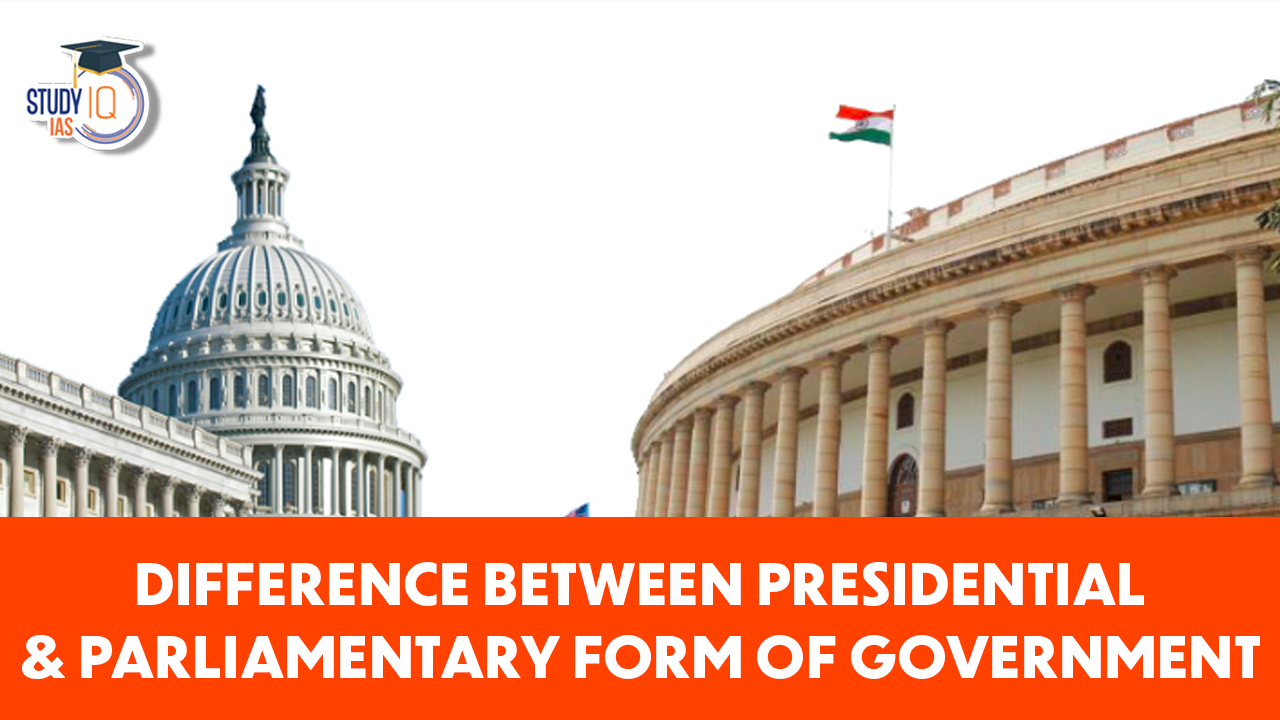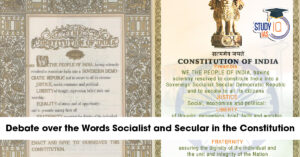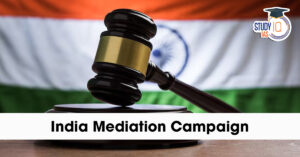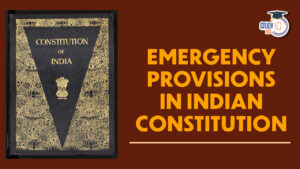Table of Contents
Difference between Presidential and Parliamentary Form of Government
A parliamentary form of administration is distinguished from a presidential style of government by the tight interaction that exists between the legislative and the executive branch. The Prime Minister, who is also the leader of the ruling party, is in charge of this system of government. In contrast, the presidential form of government places the President in charge of both the state and the federal government. The difference between the parliamentary and presidential forms of government resides in how the legislative, executive, and judicial branches are separated from one another.
Difference between Presidential and Parliamentary Form of Government Introduction
The main distinction between the presidential and parliamentary systems of government is that India uses the parliamentary system, which was adapted from the British system. In contrast, the US has a presidential system in which the President of the nation has absolute power. Studying the presidential and parliamentary systems of government is crucial to understanding both Indian and global politics.
Presidential System of Government
There are two executives in this style of governance. The head of the state and the nominal executive is the president. The president’s job is mostly ceremonial in nature. The real executive and leader of the government, the prime minister has the most authority along with the cabinet. Consequently, it is referred to as the “cabinet form of government”.
Because the parliament is directly answerable to the people, it is sometimes referred to as the “responsible government.” The legislature holds the executive accountable. As a result, there is not a clear division of powers as there is in a presidential system. Germany, Italy, Japan, the United Kingdom, India, Portugal, and other nations with a parliamentary style of government are a few examples. Articles 74 and 75 of the Indian Constitution deal with parliamentary form of government provisions at the union level, whereas articles 163 and 164 deal with state level parliamentary form of government requirements.
Features of the Presidential System
Legislative acts are subject to the executive’s (President’s) veto. A vote of no-confidence in the legislature cannot be used to oust the President because of his set term in office. In general, the President has the authority to commute or pardon criminal sentences. Either the electoral college or the general public directly elects the president.
Advantages of Presidential System
As a result of the three branches of government’s independence from one another, administration efficiency has been considerably increased. The President can appoint professionals in various professions to lead pertinent departments or ministries because the executive branch need not be made up of legislators. This will guarantee that the government is made up of skilled and knowledgeable individuals.
Government of this kind is reliable. He need not be concerned about losing the government because the president’s tenure is fixed and not dependent on legislative support. There is no threat of the government abruptly falling. The president is not under any political duress to make choices. Political parties do not try to overthrow the government because its term is set.
Disadvantages of Presidential System
The executive and the president can become authoritarian because the legislative has no control over them. Since the division of powers is more clearly defined here, there may be regular clashes between the two branches of government, particularly if the president’s political party is not the majority in the legislature.
Due to time wastage, this may cause efficiency to decline. The rigidity of presidential systems is frequently criticized. It’s not flexible enough. The arrangement grants the president broad patronage rights. He is free to pick the executives he wants here. As a result, those connected to the president (relatives, business partners, etc.) gain positions in the administration.
Parliamentary System of Government
India chose a parliamentary system of governance primarily because the English system had a significant effect on the constitution’s writers. The parliamentary model would only function to accommodate the numerous and various groups that make up our nation, as the founding fathers also understood. Additionally, the presidential system’s strong division of powers would lead to disputes between the executive and legislative branches, something our newly independent nation could not afford.
There are more parliamentary governments than there are presidents in the globe. In this system, the legislative normally has the final say, and the administration answerable to it. ‘Responsible Government’ and the Cabinet system of government are other names for it.
Features of the Parliamentary System
The legislature is comprised of the Prime Minister, the Council of Ministers from the executive branch, and the Parliament. The fact that the prime minister and ministers are chosen from among the lawmakers suggests that the legislative branch produces the executive branch. The legislature holds the executive accountable. There is a collective duty, meaning that the Council as a whole is accountable for each minister’s actions.
The real executive and the nominal executive are the two executives. The real executive is the Prime Minister, who is the head of government, not the head of state (president or monarch). This style of administration requires that cabinet meetings be private and not intended for public disclosure. The Prime Minister is in charge of this type of government. Typically, the party leader who secures a majority in the lower house is chosen to serve as prime minister.
Bicameral legislatures are used in the majority of parliamentary democracies. Having a majority in the lower house determines how long the government will be in power. The council of ministers must resign if a motion of no confidence in the government is unsuccessful. A new administration will be formed after elections.
Advantages of Parliamentary System
It is simpler to enact laws and put them into effect because the executive is a part of the legislature and normally the majority of the legislature supports the government. There is no authoritarianism since the executive is answerable to the legislature and is subject to a motion of no confidence. Furthermore, power is not centralized like it is under the presidential system. Members of the legislature have the power to interrogate the government, discuss issues of public concern, and exert pressure. The executive’s actions are subject to scrutiny by the parliament.
Under this arrangement, the parliament provides representation to the nation’s many groups. This is particularly significant for a nation like India. The method is flexible because it is simple to replace the PM if necessary. Winston Churchill succeeded Neville Chamberlain as Prime Minister of Great Britain during the Second World War. In contrast to the presidential system, where a president can only be changed after serving the full term or in the event of an impeachment or disability.
Disadvantages of Parliamentary System
The executive branch cannot always be held accountable by the legislative since there is no real division of powers. If the government holds a sizable majority in the house, this is particularly true. Additionally, lawmakers are unable to employ their free will and cast votes in accordance with their beliefs and understanding due to anti-defection laws. They must adhere to the party line. The system produces lawmakers who solely want to serve in the executive branch. They lack the necessary expertise to pass laws.
If there is no one largest party after the elections, there is instability because governments can only last as long as they can demonstrate a majority in the parliament. Coalition governments typically have a limited lifespan and are highly unstable. As a result, the administration must concentrate on maintaining power rather than worrying about the welfare or state of the populace. The ruling party should be represented in the executive. It eliminates the possibility of hiring subject matter specialists. The Council of Ministers typically hesitates before making risky and long-term policy decisions because it does not have a definite tenure.
The parliamentary system, where partisan interests override national interests, makes party politics more obvious. The power of civil servants is considerable. They provide advice to the ministers on a variety of issues and are not accountable to the legislature.
Difference between Presidential and Parliamentary Form of Government List Representation
Here is given the difference between Presidential and Parliamentary form of government in list representation:
| Basis | Parliamentary Form of Government | Presidential Form of Government |
| Accountability | The legislature holds the executive accountable. | The legislature is not accountable to the executive |
| Executive | Dual form | Singular form |
| Dissolution of the lower house | Before the lower house’s tenure expires, the prime minister has the power to dissolve it. | Lower house cannot be dissolved by the president. |
| Ministers | Another significant distinction between the Parliamentary and Presidential Forms of Government is that ministers are exclusively appointed from among elected MPs, as opposed to the Presidential Form of Government. | Appointments may be made to those outside the legislature. |
| Power Separation | No clear separation of powers is implied. | It carefully adheres to the power separation principle. |
| Tenure | Tenure is not fixed | Tenure is fixed |
| Party Discipline | There is more party discipline. | There is less party discipline. |
| Examples | Example is United Kingdom and India | Example is United States and Costa Rica |
Difference between Presidential and Parliamentary Form of Government UPSC
Even while both the parliamentary and presidential systems of government are democracies, they have certain key distinctions. The type of government is selected based on the particular requirements of the nation and its sociopolitical structure. Today, practically every nation in the globe has made the switch to democracy and operates under either a presidential or parliamentary system of governance.


 Indian Secularism: Constitutional Provis...
Indian Secularism: Constitutional Provis...
 India Mediation Campaign, Objectives, Pr...
India Mediation Campaign, Objectives, Pr...
 Emergency Provisions in Indian Constitut...
Emergency Provisions in Indian Constitut...





















